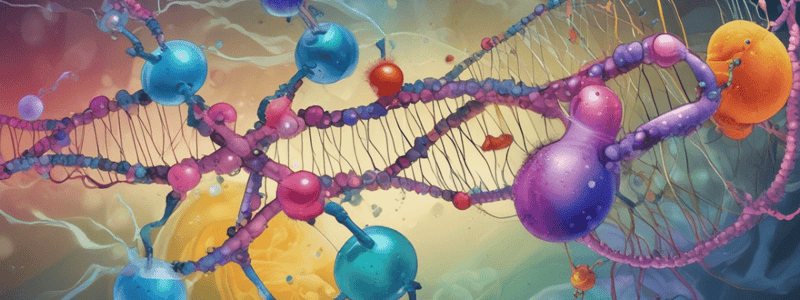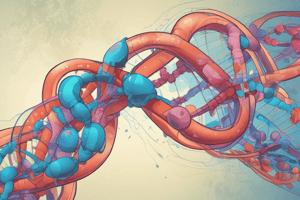Podcast
Questions and Answers
What is the primary function of epigenetic modifications in regulating gene expression?
What is the primary function of epigenetic modifications in regulating gene expression?
- To alter the underlying DNA sequence
- To influence mRNA stability
- To activate or repress gene transcription (correct)
- To initiate translation
What is the primary mechanism of transcriptional regulation?
What is the primary mechanism of transcriptional regulation?
- Binding of transcription factors to specific DNA sequences (correct)
- Binding of transcription factors to histone proteins
- MicroRNA-mediated regulation
- Removal of introns and joining of exons
Which of the following is a mechanism of post-transcriptional regulation?
Which of the following is a mechanism of post-transcriptional regulation?
- DNA methylation
- Chromatin remodeling
- mRNA localization (correct)
- Gene knockout
What is the primary function of microRNAs in regulating gene expression?
What is the primary function of microRNAs in regulating gene expression?
What is the primary mechanism of gene silencing?
What is the primary mechanism of gene silencing?
What is the primary application of gene silencing in biotechnology?
What is the primary application of gene silencing in biotechnology?
Flashcards are hidden until you start studying
Study Notes
Gene Expression Regulation
Epigenetic Modification
- Refers to heritable changes in gene function that occur without a change in the underlying DNA sequence
- Involves the addition of chemical groups to DNA or histone proteins
- Types of epigenetic modifications:
- DNA methylation: addition of a methyl group to cytosine residues in CpG islands
- Histone modification: addition of acetyl, methyl, or phosphate groups to histone proteins
- Chromatin remodeling: alteration of chromatin structure to allow or deny access to transcription factors
- Epigenetic modifications can:
- Activate or repress gene transcription
- Influence chromatin structure and accessibility
- Play a role in development, cell differentiation, and disease
Transcriptional Regulation
- Regulation of gene expression at the level of transcription initiation
- Involves the binding of transcription factors to specific DNA sequences
- Transcription factors can:
- Activate transcription by binding to enhancers or promoters
- Repress transcription by binding to silencers or promoters
- Types of transcriptional regulation:
- Positive regulation: activation of transcription
- Negative regulation: repression of transcription
- Induction: increased transcription in response to a signal
- Repression: decreased transcription in response to a signal
Post-transcriptional Regulation
- Regulation of gene expression after transcription has occurred
- Involves the processing, localization, and translation of mRNA
- Mechanisms of post-transcriptional regulation:
- mRNA splicing: removal of introns and joining of exons
- mRNA localization: targeting of mRNA to specific cellular locations
- mRNA stability: regulation of mRNA degradation rates
- Translation initiation: regulation of protein synthesis initiation
- MicroRNA-mediated regulation (see below)
MicroRNA Regulation
- Small non-coding RNAs that regulate gene expression by binding to mRNA
- Mechanism:
- MicroRNAs bind to complementary mRNA sequences
- Blocking translation or inducing degradation of target mRNAs
- MicroRNA function:
- Regulation of gene expression in response to environmental cues
- Regulation of cellular processes, such as cell growth and differentiation
Gene Silencing
- Permanent inactivation of a gene or gene product
- Mechanisms of gene silencing:
- Epigenetic modification: heritable changes to chromatin structure or DNA methylation
- RNA interference (RNAi): degradation of specific mRNAs by small RNAs
- Gene knockout: targeted disruption of a gene sequence
- Gene silencing can be used to:
- Study gene function
- Treat genetic diseases
- Develop novel therapies
Studying That Suits You
Use AI to generate personalized quizzes and flashcards to suit your learning preferences.




